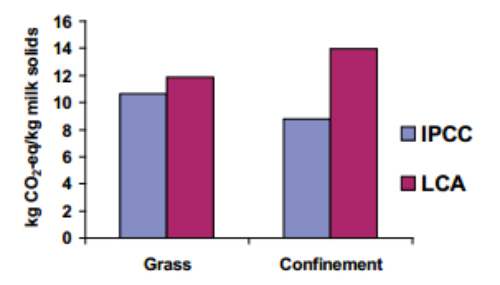



The Effect of Greenhouse Gas Emissions (GHG) Accounting Methodology on Emissions Estimates from Dairy Systems
Globally, the dairy industry is currently faced with the challenge of increasing production to satisfy growing demand (FAO, 2006), while meeting an international obligation to reduce greenhouse gas (GHG) emissions.This issue has led to an increasing interest in reducing the GHG emission intensity (kg of GHG per unit of milk) of dairy production. However, different methods are used to model GHG emissions from dairy systems, namely Life cycle assessment (LCA) and the Intergovernmental Panel on Climate Change (IPCC) method. The objective of this paper was to compare the IPCC and LCA methodologies in estimating GHG emissions from a grass-based and a confinement dairy system.
Materials and Methods
The input data used to model GHG emissions from the
dairy systems investigated in this study were based on
the study of Olmos et al. (2009). Holstein-Friesian cows
were blocked based on genetic merit, parity, calving
date, body condition score and predicted milk yield and
assigned randomly from within pairs to either the grassbased or confinement system. Grazed grass was the
main feed offered in the grass-based system. Grass
silage and concentrate were offered when pasture
growth was unable to meet the requirements of the herd.
Total mixed ration was fed in the confinement system,
which consisted of maize silage, grass silage, barley
straw and concentrate.
Greenhouse gas emissions were calculated using a dairy
farm GHG model (O’Brien et al., 2011). The model
estimates the main GHG emissions: carbon dioxide
(CO2), nitrous oxide (N2O), and methane (CH4). The
GHG model operates in combination with the
Moorepark Dairy System Model (MDSM, Shalloo et al.,
2004). The MDSM defines key parameters (e.g. animal
feed budgets) required for the GHG model to estimate
emissions. The GHG model quantified emissions using
the IPCC and LCA methods. The IPCC method only
considers GHG from on-farm sources. In contrast, the
LCA approach quantifies emissions from all processes
associated with dairy production up to the point milk is
sold from the farm. Thus, the approach includes
emissions from the manufacture of purchased inputs e.g.
fuel. Greenhouse gas emissions were estimated in terms
of their 100-year global warming potentials (CO2-eq),
which on a weight basis relative to CO2 was set to a
factor of 21 for 1 kg of CH4 and 310 for 1 kg of N2O
(IPCC, 1996). The main output of the GHG model for
both methods was a static account of dairy systems
annual GHG emissions, which were expressed, per kg
of milk solids (MS). Besides producing milk, dairy
farms also produce meat. Thus, GHG emissions were
allocated between these products using a physical
allocation approach developed by the IDF (2010), where
impacts were related to the cow’s use of feed to produce
milk and meat. Allocation of GHG emissions was also
necessary for some concentrate by-products e.g.
distillers grain. For these inputs, emissions were
allocated based on their relative economic value
because a physical relationship could not be established.
Results and Discussion
The GHG emissions of the grass and confinement systems, calculated using the IPCC and LCA methods, are shown in Figure 1. The IPCC results show that GHG emission/kg of MS were, on average, 14.5% lower for the confinement system relative to the grass system. However, the LCA results show that the confinement system increased GHG emission/kg of MS by 18% compared to the grass system. The re-ranking of these two dairy systems GHG emission/kg of MS occurred because the IPCC method excludes emissions associated with farm imports e.g. concentrate. These findings highlight that the most effective dairy system to reduce national emissions could increase global dairy emissions.
 |
| Fig. 1. Greenhouse gas emission of a grass and a confinement dairy system calculated using the Intergovernmental Panel on Climate Change (IPCC) and Life Cycle Assessment (LCA) methods. |
Conclusion
This study shows that to reduce GHG emissions per unit of milk, approaches such as life cycle assessment, which consider on and off-farm GHG emissions should be used. Thus, reform of the present IPCC framework is needed to enable quantification of the impact of mitigation strategies on global GHG emissions.
This study was funded by DAFF (RSF-07-517)
References
FAO. (2006). World Agriculture: towards 2030/2050.
Interim Report, Rome, Italy.
IPCC. (1996). Climate Change 1995. Cambridge Uni.
Press, Cambridge, UK
IDF. (2010). Bulletin of the IDF 445.
O'Brien, D., Shalloo, L., Buckley, F., Horan, B.,
Grainger, C., Wallace, M. (2011) Agric. Ecosyst.
Environ. 141: 39-48.
Olmos, G., Mee, J.F., Hanlon, A., Patton, J., Murphy,
J.J. and Boyle, L., (2009). Anim. Welfare 18, 467-476.
Shalloo, L., Dillon, P., Rath, M. and Wallace, M.
(2004). J. Dairy Sci. 87: 1945-1959


